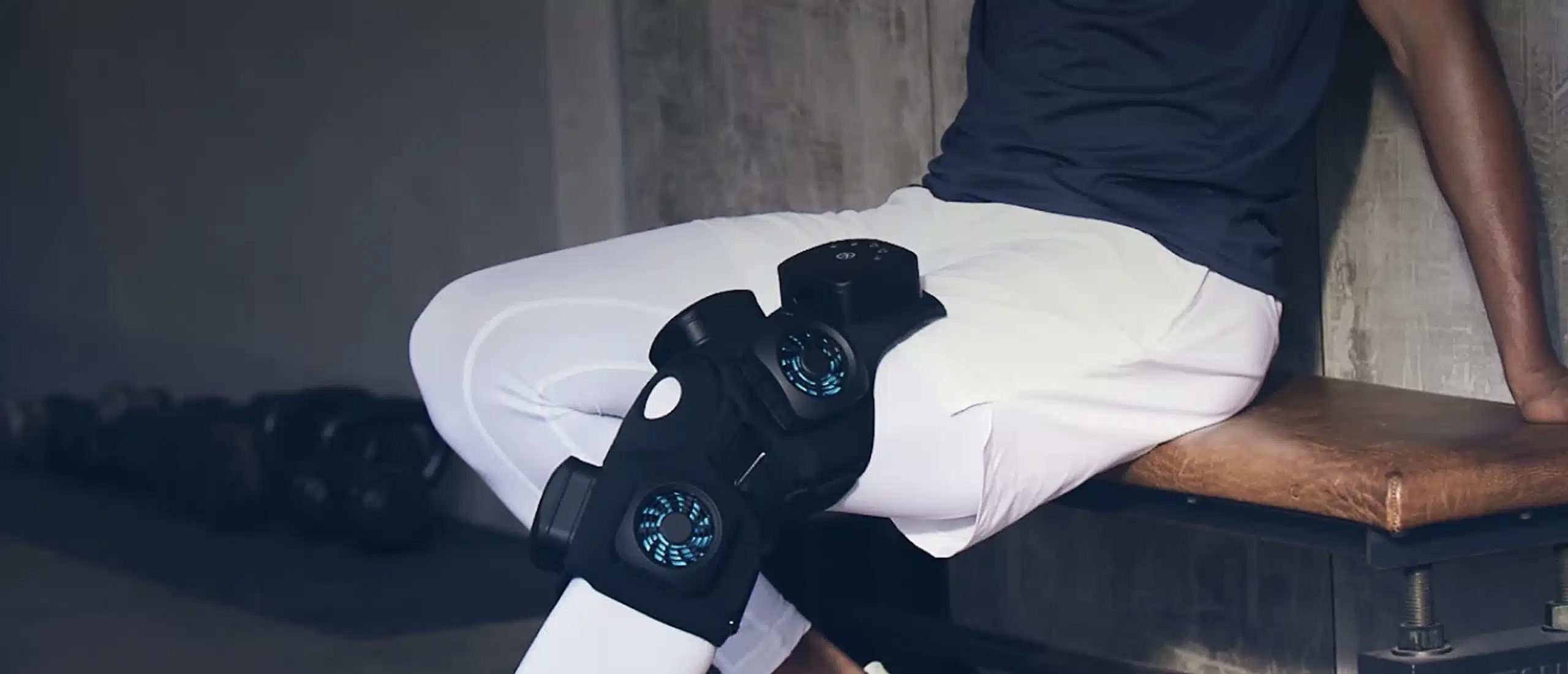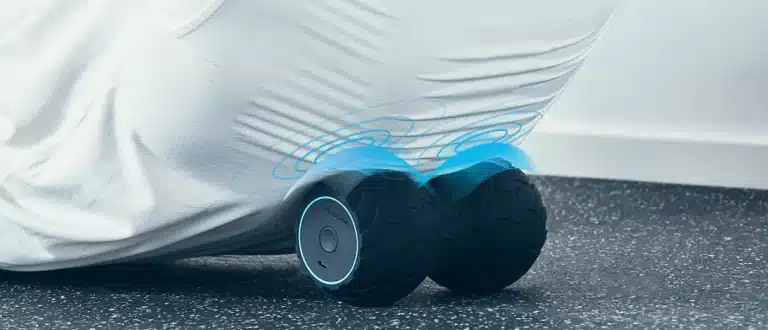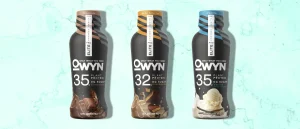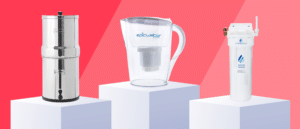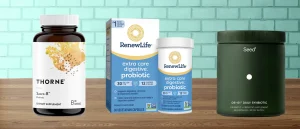Knees Hurt After Exercise? Consider a $399 Icy Hot Machine
Can you put a price on alleviating pain? How much is too much when it comes to workout recovery? Venerable makers of dozens of muscle recovery tools Therabody would seemingly like to find out with one of its latest inventions, the RecoveryTherm Knee Massager. For $399, the knee sleeve works a bit like a supercharged Icy Hot pack—it heats, it cools, and it throws in compression and percussion massaging (what Therabody is best known for). Here’s what you should know about it before you consider buying.
What Does the Therabody Knee Massager Do?
Hot-cold therapy
Temperature therapy—hot or cold—is a fairly established means for muscle recovery. It works like this: heat increases blood flow and metabolic processes, effectively speeding the healing and recovery process and reducing pain; cold decreases blood flow and limits inflammation, therefore also reducing pain. When you combine the two (often called contrast therapy) you get a provably effective means for reducing delayed onset muscle soreness (1), general athletic recovery (2), and chronic pain (3).
Therabody’s knee massager can run warm, cold, or a blend of the two, so it’s designed to effectively hit all the basics of thermotherapy.
Percussion therapy
The effectiveness of percussion massagers, like those Therabody makes and is chiefly known for, seems to be generally supported by research, especially when it comes to reducing DOMS (4) and as a warm-up tool (5). Therabody’s one-size-fits-all knee massager has three modes of massage therapy, as well as hybrid modes that blend percussion massaging with thermotherapy.
Infrared light therapy
The least understood of this trio of therapeutic methods, infrared light therapy is experiencing a massive surge in the consumer product world. Generally, infrared light therapy—more accurately called Far Infrared Radiation—is known to stimulate cells and body tissue. Therabody’s knee massager has germanium, a FIR-emitting alloy, woven into the fabric of the knee sleeve. Research is relatively raw in regard to non-powered infrared therapy, but early signs are positive (6).
What’s Good About the Therabody Knee Massager?
Science-supported fitness recovery
As I wrote in the “What Does the Therabody Knee Massager Do?” section, this device’s core functions—thermotherapy and percussion therapy—are supported by years and years of good science. The heating and cooling of an area on the body does work to quicken recovery, reduce pain, and limit inflammation.
I used the knee massager after heavy lower-body weightlifting sessions, some moderate cardio, and a couple pickup soccer games and I found myself looking forward to slapping the sleeve on my knees and sinking into my sofa for a bit (each cycle takes about 15 minutes). I’d say from a recovery standpoint, it’s best suited for those activities that places repeated strain on your knees and the muscles surrounding muscles, rather than weightlifting sessions where a few short bursts of movement are needed. It was after soccer games and five-or-so mile jogs where I felt the most benefit from the massager.
Hyperice, Therabody’s direct rival in the super-premium-workout-recovery world, has its own version of this product called the Hyperice X, which comes with the same $399 price tag. A study (helmed by a member of Hyperice’s medical advistory board) found that the product, which is extremely similar in terms of features and function, “demonstrated effectiveness in affecting pain reduction, swelling, and knee [range of motion].”
Feels premium
If you’ve owned a Therabody product, you know two things are true: they are expensive, and they feel expensive. This may seem like an obvious revelation, but having tested dozens of muscle recovery tools I’m confident in my belief that this is not always the case.
The knee sleeve is made of a heavy neoprene and is loaded with four hot-cold fans, each with a metal plate beneath them used as a conductor for thermotherapy. Sitting on top of the sleeve (above your knee, when worn) is the control panel where the battery slots in. Altogether it feels durable and premium, and just generally heavy, which is simple but reliable sign of a solid build. For $399 you’re gonna want a product to talk the talk—that’s exactly what the premium-ness of Therabody’s knee massager does.
Extremely relaxing
Beyond performance and feeling like you bought a high-end product, I found myself wanting to use it. Yes, I mostly used it after exercise, but some nights I strapped it on my knee, cracked a cold beer, and melted into the sofa for half an hour of bliss. I’d argue this is uncommon among recovery tools (especially the more, ahem, painful ones), which, for me, makes it more valuable. A desire to use something makes it simpler to fold into your day-to-day routine, rather than force it in and rely discipline alone.
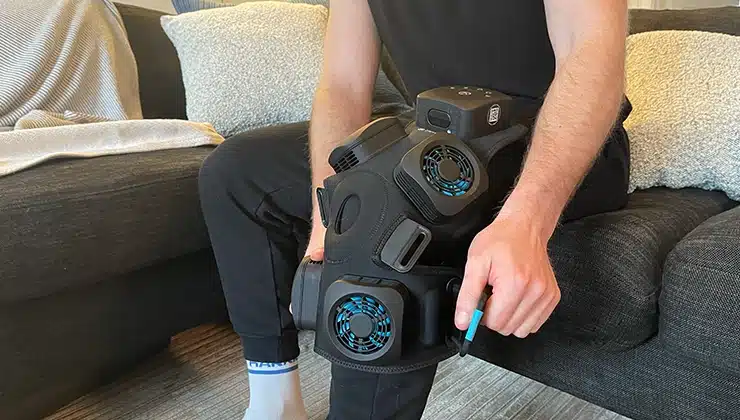
What’s Not Good About the Therabody Knee Massager?
Battery runes out of juice fast
No doubt the most egregious issue with Therabody’s knee massager is the battery life and design. If you run the hot-cold massage cycle, which is the option you’ll choose most often as it utilizes all of the product’s recovery features, the battery lasts for 30 minutes. Each cycle lasts 15 minutes, so you can hit both knees on one battery charge. This is not long enough.
What if my partner wants to use it? They’ll need to wait two hours for the battery to fully recharge. If this product was half the price its battery runtime might be forgivable—but it’s $400, and you expect a little more out of something with that kind of price tag.
It should be noted that the battery lasts about 60 minutes when run only in cold mode, and 90 minutes in heat mode. This is what the combined mode should be capable of or, at the very least, allow people to use the massager while it’s plugged in, which isn’t possible with the current product design.
Fit is inconsistent
The instruction manual says you can use the knee massager with your leg fully extended or at a 90-degree angle. Fully extended doesn’t place the hot-cold conductor plates flush with your knee, which means you’re not really getting to use the product as intended. After some tightening and loosening, you can get a little closer to a comfortable fit with your knee flexed 90 degrees, but it doesn’t feel 100 percent secure. It can be frustrating for the first few uses as you figure out the goldilocks-point of tightening the straps around your knee.
Is the Therabody Knee Massager Worth It?
The product combines three therapies proven—to different extents, in fairness—to make your muscles feel better. Does it work, though? We’re testing the product now and will report back with our first-hand experience.
Hyperice, Therabody’s direct rival in the super-premium-workout-recovery world, has its own version of this product called the Hyperice X, which comes with the same $399 price tag. A study (helmed by a member of Hyperice’s medical advistory board) found that the product, which is extremely similar in terms of features and function, “demonstrated effectiveness in affecting pain reduction, swelling, and knee [range of motion].” If you struggle with any of those issues in your knees, a contrast therapy knee massager may be worth considering—though we’d start with stretching and other attempts at active recovery before investing $399.
The Bottom Line
The product combines three therapies proven—to different extents, in fairness—to make your muscles feel better. I loved using it after playing sports, jogging, and sometimes lifting weights. For $399, though, I wanted the battery to last longer than it did and the fit to be more flush. If you’re an athlete with frequent knee problems or soreness, though, I think it’s absolutely worth the cash.
References
1. Wang, Yutan et al (2021). Heat and cold therapy reduce pain in patients with delayed onset muscle soreness: A systematic review and meta-analysis of 32 randomized controlled trials.
2. Cochrane, Daryl J. (2004). Alternating hot and cold water immersion for athlete recovery: a review.
3. Liu, Xiaoguang, et al (2009). Randomized trial comparing exercise therapy, alternating cold and hot therapy, and low intensity laser therapy for chronic lumbar muscle strain.
4. S. Broadbent, et al (2008). Vibration therapy reduces plasma IL6 and muscle soreness after downhill running.
5. Konrad, Andreas, et al (2020). The Acute Effects of a Percussive Massage Treatment with a Hypervolt Device on Plantar Flexor Muscles’ Range of Motion and Performance.
6. Vatansever, Fatma et all (2012). Far infrared radiation (FIR): its biological effects and medical applications.



